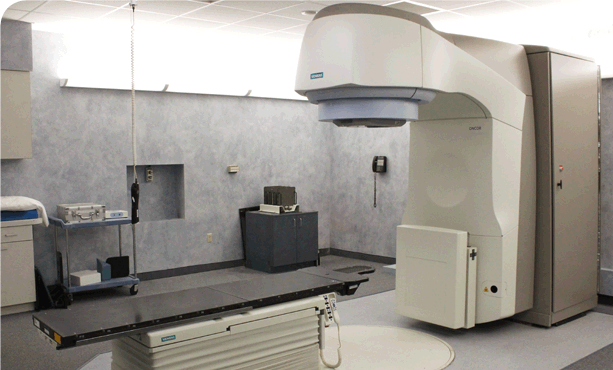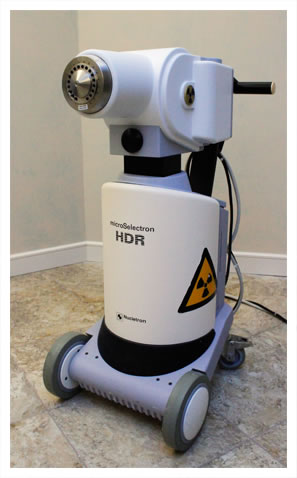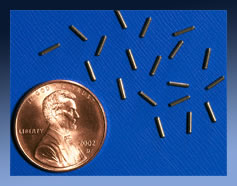The course of radiation therapy is composed of four steps:
- Consultation
(under 'Radiation Preparation')
- Treatment Planning
(under 'Radiation Preparation')
- Radiation Treatment
(this page)
- Follow up
(this page)


Radiation Therapy
Treatment provided by the Western Illinois Cancer Treatment Center:
- External Beam Therapy
where a beam of radiation is directed through the skin to the cancer and the immediate surrounding area. Three types of external beam therapy are available:
• Three-Dimensional Conformal Radiation Therapy (3D-CRT)
• Intensity Modulated Radiation Therapy
(IMRT)
• Image-Guided Radiation Therapy (IGRT)
- High Dose Rate (HDR)
radiation therapy involves placing radioactive material into a tumor or into its surrounding tissue:
• Brachytherapy
• SAVI®

The following is a list of the specific types of cancer that we treat at the Cancer Center:
| Anal | Larynx | Sinus |
| Bladder | Leukemia | Skin |
| Bone | Lung | Spine |
| Brain | Lymphoma | Stomach |
| Breast | Nasal | Testicle |
| Cervical | Neck | Thymus |
| Colon | Ovarian | Thyroid |
| Endometrial | Pancreas | Tongue |
| Esophagus | Parotid | Tonsil |
| Gallbladder | Prostate | Uterus |
| Hypopharynx | Rectal | Vagina |
| Kidney | Renal |

Brachytherapy:
Brachytherapy is internal beam, HDR (High Dose Rate) radiation therapy that involves placing radiactive material into a tumor or into its surrounding tissue. Because the radiation sources are placed so close to the tumor, your radiation oncologist can deliver a high dose of radiation directly to the cancer cells.
The radioactive sources used in brachytherapy, such as thin wires, ribbons, capsules or seeds, com in small, sealed containers. These sources may be implanted permanently or temorarily.
A permanent implant remains in the body after the sources are no longer radioactive. Other radioactive sources are placed temporarily inside the body and are removed after the right amount of radiation has been delivered.
Breast brachytherapy is delivered using the SAVI® Catheter. Also known as Interstitial Breast Brachytherapy, this technology allows a breast cancer patient to achieve a full course of treatment (post-lumpectomy) in five days instead of the customary six week treatment with a decidedly similar outcome. The SAVI® treatment course, following a lumpectomy, is a viable alternative to masectomy.

External Beam Radiation Therapy:
During External Beam Radiation Therapy, a beam of radiation is directed through the skin to the cancer and the immediate surrounding area in order to destroy the main tumor and any nearby cancer cells.
To minimize side effects, the treatments are typically given five days a week, Monday trough Friday, for a number of weeks. This allows doctors to get enough radiation into the body to kill the cancer while giving healthy cells time each day to recover.
Intensity Modulated radiation Therapy:
IMRT is a specialized form of Three-Dimensional Conformal Radiation Therapy (3D-CRT) that allows radiation to be more exactly shped to fit the tumor. With IMRT, the radiation beam can be broken up into many 'beamlets' and the intensity of each beamlet can be adjusted individually.
Using IMRT, it may be possible to further limit the amount of radiation to healthy tissue near the tumor.

Comparative size of radioactive seeds
Specific types of cancer and/or conditions:
Angiosarcoma
Astrocytoma
Basal Cell Skin Cancer
DCIS
Cancer of all types/areas (see list)
Chronic Lymphoid Leukemia
Glioblastoma Multiforme
Graves Disease
Inflammcatory Breast Cancer
Lelomyosarcoma
Male Breast Cacncer
Melanoma
Metastatic Cancer to the Bladder
Metastatic Cancer to the Brian
Metastatic Cancer to the Bone
Metastatic Cancer to the Spine
Metastatic Cancer to the Stomach
Multiple Myeloma
Non-Hodgkins Lymphoma
NonSmall Cell Lung Cancer
Plasmocytoma
Sarcomas of the Skin
Seminoma
Small Cell Lung Cancer
Spinal Cord Compression
Squamous Cell Skin Cancer
Testicular Cancer
(May not list all types of cancer we treat. Contact us for more specific information).




